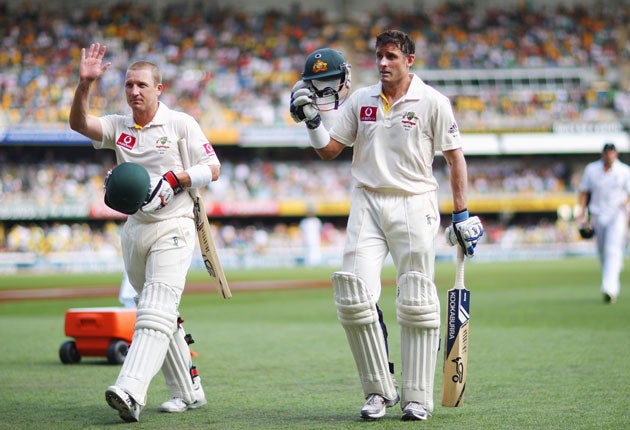Historic batting partnership puts paid to English optimism

Your support helps us to tell the story
From reproductive rights to climate change to Big Tech, The Independent is on the ground when the story is developing. Whether it's investigating the financials of Elon Musk's pro-Trump PAC or producing our latest documentary, 'The A Word', which shines a light on the American women fighting for reproductive rights, we know how important it is to parse out the facts from the messaging.
At such a critical moment in US history, we need reporters on the ground. Your donation allows us to keep sending journalists to speak to both sides of the story.
The Independent is trusted by Americans across the entire political spectrum. And unlike many other quality news outlets, we choose not to lock Americans out of our reporting and analysis with paywalls. We believe quality journalism should be available to everyone, paid for by those who can afford it.
Your support makes all the difference.England had plenty of reason for optimism going into the third day of the First Test. It was brutally extinguished over more than six and a half hours by a record sixth wicket stand of 307 between Mike Hussey and Brad Haddin.
The partnership was the highest for any wicket at the Gabba and it effectively ended the tourists’ chances of winning the match. The ground is not called Fortress Gabba for nothing. Both men scored centuries, Hussey his highest Test innings of 195 and Haddin 136.
The scoreboard tells but part of the story, albeit the important part. In an enthralling contest in the morning session the match might easily have tilted England’s way. Jimmy Anderson bowled an outstanding spell from the Vulture Street End and might, on another day, have swept away Australia’s innings.
He was denied the wicket of Hussey twice. First, Aleem Dar gave Hussey out leg before but the batsman asked for the decision to be reviewed and was reprieved when replays showed the ball had pitched outside leg stump. Shortly after Anderson appeared to have his man stone dead but Dar turned down their appeal. Replays showed he was wrong but England had already used their two permitted reviews.
Anderson might still have dismissed both men as they played and missed against the moving ball. But they survived and once having done so they were never under pressure again. Gradually, they became more assertive. Haddin drove wonderfully straight and Hussey, while being denied the balls for his favourite pull shot, was at ease driving through the off side.
Haddin, dropped on 63 by Alastair Cook running back from mid-off and on 113 by Anderson running back from mid-wicket, was first to go, caught at slip off Graeme Swann. Hussey soon followed trying to reach his double hundred with a six and the tail was wrapped up. Steve Finn, in his first Ashes Test, finished with six wickets.
England, instead of being ahead as they had hoped they might be in the morning, were 221 behind. Andrew Strauss survived a perilously close call for leg before when he shouldered arms to his first ball. The review asked for by Australia indicated that the ball was going over the top – just. England survived the 15 overs at the end of the day and finished 202 behind.
Join our commenting forum
Join thought-provoking conversations, follow other Independent readers and see their replies
Comments